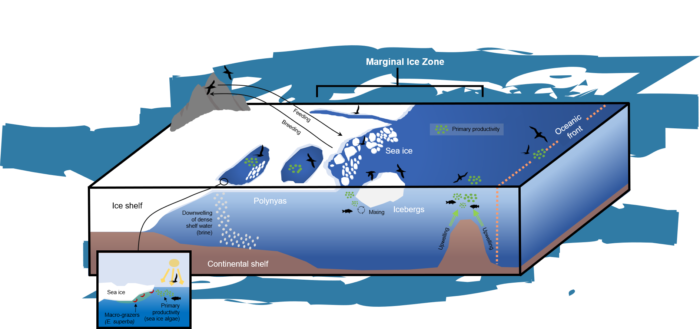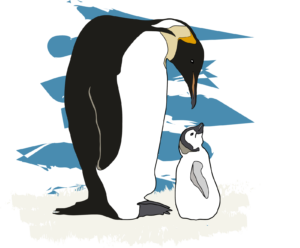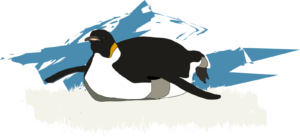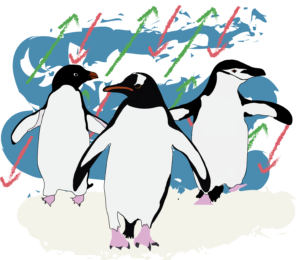
The vast expanse of Antarctic sea-ice may appear inhospitable at first, but the region supports one of the most productive ecosystems on Earth. Amongst the organisms that call Antarctica home, certain seabird species have become so well adapted to the harsh conditions that they not only survive in the region, but flourish. Like all Antarctic organisms, seabirds are intricately linked to the continent’s sea ice, dependant on it for survival. With a warming climate, sea ice conditions are changing, with knock on impacts for the Antarctic’s feathered inhabitants. Here, I discuss how sea ice is impacting some of the Antarctic’s most enigmatic seabirds, and what we can learn from their responses.
Antarctic seasonal sea-ice zones represent one of the largest and most productive habitats on the planet. The sea ice contributes significantly to the region’s primary productivity, acting as a substrate for the growth of algal biomass, which provides a crucial food source for a keystone species, Antarctic krill (Euphasia superba). Antarctic krill are dependent on sea ice throughout all stages of their life cycle and are a fundamental part of the Antarctic trophic web forming the base of a food chain that supports the region’s marine predators, including seabirds. During the Austral spring and summer, melting of sea-ice triggers phytoplankton blooms that support vast numbers of krill and their predators.
Antarctic seabirds can be divided into assemblages based on their association with sea ice. Those that are ‘ice-obligate’ are found in year-round association with sea ice and nest on the continent. These species are known as pagophilic. Then there are species which are ‘ice-tolerant’ and ‘ice-avoidant’. These feed in southerly sea-ice environments mainly in the summer months, moving northwards during the austral winter to feed in the productive waters of boundary currents, nesting for the main part on sub-Antarctic islands.
Despite differing in their degree of association, all Antarctic seabirds are in some way linked to the sea ice due to its influence on the Southern Ocean’s productivity.
Across the Antarctic continent, different regions have experienced different patterns of sea ice advance and retreat. Very broadly, the overall trend is one of ice loss in West Antarctic, and ice increase in East Antarctica. Due to the variability in their association with the sea ice, the level of vulnerability of Antarctic seabirds to changes in sea ice conditions varies at both a species and population level.
Polynyas: Antarctic oases
When a seabird has a chick to raise, they become central-place foragers. This term means that their foraging trips are limited in distance and duration, as they are required to return to their nest to feed their young. In most seabird groups, while incubating the egg or the young chick, the adults take alternate feeding trips, with one heading out to sea to catch food both for the chick and itself, whilst the other stays at the nest and guards the chick.
Once the chick is strong enough to be left alone, both parents can leave to forage simultaneously. These foraging trips can last for several days, with the adults travelling hundreds of kilometres to reach productive feeding grounds.
For Antarctic seabirds foraging in the rich marginal ice zone or pelagic waters off the continental shelf, central place foraging has major implications. It narrows the availability of already limited suitable breeding space in continental Antarctica: all species bar the emperor penguin (and potentially Adélie penguins) require ice-free nesting grounds with exposed rock. With less than 1% of the mainland ice-free, suitable coastal nesting habitats may be separated from foraging grounds by vast expanses of land-fast or sea ice, where food is inaccessible. As a result, Antarctic seabird colonies tend to cluster away from coastal areas with heavy sea ice.
However, in areas where concentrated sea ice occurs adjacent to colonies, respite is provided in the form of polynyas, areas of open water found in expanses of persistent sea ice (figure 1). During the summer months, the melting of ice in marginal ice-zones at the edges of these polynyas seeds phytoplankton blooms, leading to hotspots of productivity and prey availability for seabirds. The proximity of these productive foraging grounds to seabird colonies is most important during the breeding season, when energy demands on the birds are highest.
Emperors of the ice
The association of Antarctic seabirds and sea ice cannot be discussed without reference to the most pagophilic species of all: the emperor penguin, Apenodytes forsteri.
The largest of the penguin species, emperor penguins spend the non-breeding season amongst the pack ice, feeding amongst the ice and undergoing moult standing on ice floes. Their association with ice is so strong that they even breed on stable platforms of sea ice, cradling their eggs and chicks in special brood pouches, resting them upon their feet to protect the young from the frigid conditions. Their foraging trips involve a slow waddle out to the open water within the pack ice or in polynyas. It is entirely possible for an emperor penguin to go its entire life (upwards of 15 years) without once standing on solid ground; the ultimate birds of ice and ocean.
However, no simple correlation exists between any seabird and sea ice conditions. For emperor penguins, low sea ice concentration affects the base of their food web and reduces the survival rate of adult penguins. High sea ice concentrations mean that breeding adults must travel longer distances between breeding colonies and their foraging grounds, increasing their energy expenditure. Too early a break-up of the sea ice can also lead to a loss of chicks. Studies have predicted that the decline of sea ice stability and concentration mean that all emperor penguin colonies will be in decline by 2100.
Pygoscelid penguins: Right place, wrong temperature
With a warming climate, high-latitude species are being pushed further and further poleward, with lower-latitude species moving into areas previously inhospitable to them. Penguins are no exceptions to this pattern, with changing sea ice influencing the population dynamics of the Pygoscelis or ‘brush tailed’ penguins.
The 3 living Pygoscelis penguin species, Adélie (Pygoscelis adéliae), chinstrap (P. antarctica) and gentoo (P. papua) are sympatric in the Antarctic Peninsula, requiring ice-free areas to breed and preying on primarily fish and krill. However, Adélie and chinstrap penguins rely more on sea ice for foraging, and as the ice retreats, their numbers are declining in the Peninsula. The gentoo penguins, recent colonizers of the area from further north, can thrive in open water settings.
Conversely, in the Ross Sea region of continental Antarctica, Adélie numbers are rising. Warmer temperatures and stronger winds have led to increases in sea ice extent and persistence, with a greater predictability of coastal polynyas. This shift in sea ice dynamics, paired with a retreat of the ice sheet causing more ice-free areas for breeding has facilitated an increase in the Adélie population in the region.
Snow petrels: archives of the ice
Although penguins are the most well studied of the Antarctic seabirds, they are outnumbered by the comparatively under studied flying seabirds. Procellariiformes, the order including albatrosses, storm petrels, diving petrels and the Procellariidae (shearwaters, prions, gadfly petrels and fulmarine petrels) which make up the majority of Antarctic seabirds, alongside the ubiquitous kelp gulls.
Out of the flying seabirds, the most ice-obligate of all is the snow petrel, Padrogoma nivea. Like the emperor penguin, their survival rate is closely linked to the seasonal sea ice. These snow-white, black-eyed and black-billed seabirds are the smallest of the fulmarine petrels and endemic to Antarctica, with a circumpolar distribution. They nest within the crevices between boulders on talus slopes, laying one chick per breeding season.
Snow petrels convert their prey of fish and krill, foraged almost exclusively from marginal-ice zones, into high-energy stomach oils which permit the adults to forage at a distance from the colony and still provide sufficient energy to their chicks. The oil can also be used as a defence mechanism: snow petrels eject their stomach oil at predators such as south polar skuas (Stercorarius maccormicki), and whilst defending their nesting site from competitors (and unfortunate researchers!).
This behaviour leads to the build-up of the stomach oils, guano, and detritus such as feathers and sedimentary particulates from surrounding rocks in deposits around the nesting site. The cold, arid climate of Antarctica means microbial degradation of the organic content of the stomach oil is inhibited, and the deposits can be up to a metre thick. The distribution of past snow petrel populations through time and space can be traced through the locations and ages of these stomach oil deposits.
As the petrels require ice-free talus slopes to breed, their presence infers the absence of the ice sheet. Radiocarbon dating of the basal layer of the stomach oil deposits has been used to trace local deglaciation histories.
Alongside ice sheet dynamics, the contents of the deposits can also be used as a marine environmental archive, as they reflect snow petrel foraging habits. This provides an insight into coastal ecosystems at the time of deposition.
I’m currently working as part of the European Research Council funded project ANTSIE (Antarctic Sea Ice Evolution from a novel biological archive), at Durham University, UK and the British Antarctic Survey, UK. This novel project is combining state-of-the-art tracking of snow petrels and studies of their modern diet with the palaeo-archive of the stomach oil deposits. This research takes a multi-disciplinary approach to link the modern foraging ecology of snow petrels with past sea-ice ecosystem dynamics.
Snow petrels inhabit some of the planet’s most dynamic environments, dependant on ephemeral patches of rich productivity to support their existence. Alongside providing a unique insight into past sea ice conditions, this new study will give an unprecedented glimpse into the lives of modern snow petrels by combining tracking and dietary information. With Antarctic sea ice becoming more unstable, the importance of studying ice-obligate species such as the snow petrel increases significantly. By increasing our understanding of past sea ice conditions, we can make better projections of future sea ice environments, and the fate of the ecosystems within.
Further Reading
- Arrigo &Thomas, 2004. Large scale importance of sea ice biology in the Southern Ocean. Antarctic Science, 16(4), p.471, DOI: 10.1017/S0954102004002263.
- Berg et al., 2019. Late Holocene colonisation of snow petrels (Pagodroma nivea) of the Prince Charles Mountains, Antarctica. Polar Biology, 42:1167-1173, DOI: 10.1007/s00300-019-02509-0.
- Clucas et al., 2014. A reversal of fortunes: climate change ‘winners’ and ‘losers’ in Antarctic Peninsula penguins. Scientific reports, 4:1-7, DOI: 10.1038/srep05024.
- Fraser & Ainley, 1986. Ice edges and seabird occurrence in Antarctica. BioScience 36:258-263, DOI: 10.2307/1310216.
- Jenouvrier et al., 2014. Projected continent-wide declines of the emperor penguin under climate change. Nature Climate Change 4:715-718, DOI: 10.1038/nclimate2280.
- LaRue et al., 2013. Climate change winners: receding ice fields facilitate colony expansion and altered dynamics in an Adélie penguin metapopulation. PLoS One 8:p.e60568, DOI: 10.1371/journal.pone.0060568.
- Schmidt & Ballard, 2020. Significant chick loss after early fast ice breakup at a high-latitude emperor penguin colony. Antarctic Science 32:180-185, DOI: 10.1017/S0954102020000048.
Edited by Jenny Arthur and Giovanni Baccolo
 Eleanor Maedhbh Honan (Ellie) is a current PhD researcher with Durham University, UK and the British Antarctic Survey working on the European Research Council-funded project ANTSIE: Antarctic Sea Ice Evolution from a novel biological archive. Ellie’s research focuses on modern snow petrel movement and diet in the Sor Rondane Mountains, Dronning Maud Land, Antarctic. She has an MSc in Palaeobiology from the University of Bristol, UK and a BSc in Geology from University College Cork, Ireland. She tweets as EllieOnTheRocks, you can contact her here.
Eleanor Maedhbh Honan (Ellie) is a current PhD researcher with Durham University, UK and the British Antarctic Survey working on the European Research Council-funded project ANTSIE: Antarctic Sea Ice Evolution from a novel biological archive. Ellie’s research focuses on modern snow petrel movement and diet in the Sor Rondane Mountains, Dronning Maud Land, Antarctic. She has an MSc in Palaeobiology from the University of Bristol, UK and a BSc in Geology from University College Cork, Ireland. She tweets as EllieOnTheRocks, you can contact her here.




